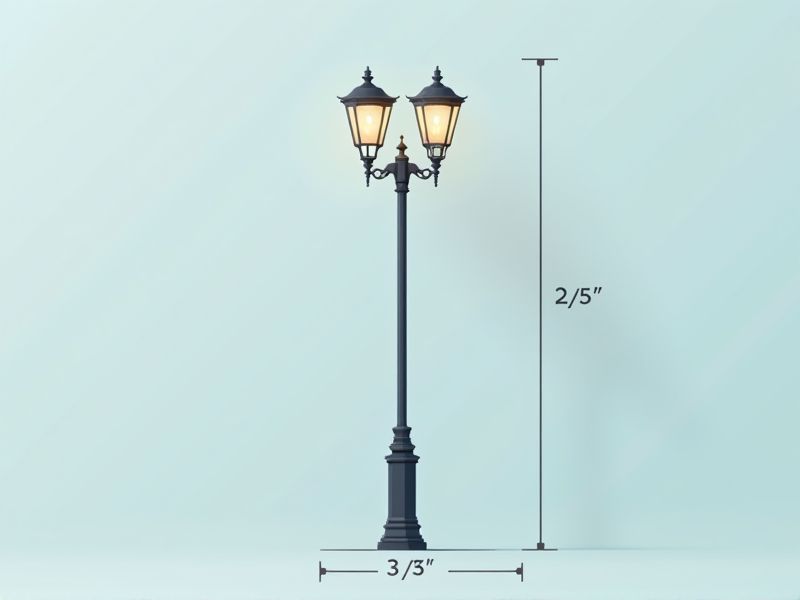
The standard dimensions of lamp posts can vary depending on their intended use and location. For most street lighting applications, lamp posts are typically between 8 to 14 feet (2.4 to 4.2 meters) tall in residential areas, while commercial or highway lamp posts often range from 20 to 40 feet (6 to 12 meters) in height. The diameter at the base usually measures around 4 to 6 inches (10 to 15 centimeters) and tapers upward for structural stability. Always check with local regulations or the manufacturer's guidelines to ensure compliance with safety and installation standards in your area.
Height
Lamp post height typically ranges from 10 to 30 feet, depending on their intended use and location. For urban areas, a height of around 12 to 18 feet is common, effectively illuminating sidewalks and roadways. In contrast, park or recreational areas may utilize taller posts, reaching up to 20 to 30 feet, to enhance visibility and safety. Choosing the right height not only ensures sufficient light distribution but also complements the surrounding architecture and landscape.
Pole Diameter
The standard pole diameter for lamp posts typically ranges from 4 to 12 inches, depending on the application and design requirements. A thicker pole, often 10 to 12 inches in diameter, is recommended for urban areas with higher wind loads and pedestrian traffic, ensuring durability and stability. Standard height for lamp posts generally varies between 10 to 30 feet, providing optimal illumination for different environments. Choosing the right pole diameter is crucial for maintaining aesthetic appeal while ensuring structural integrity and longevity in various weather conditions.
Base Size
The standard base size for a lamp post typically ranges from 12 inches to 18 inches in diameter, providing stability and support for various environments. In commercial areas, a heavier base weighing between 200 to 300 pounds is often recommended to withstand wind loads and protect against tip-overs. Your choice of base size can impact the overall aesthetics and functionality of outdoor lighting, influencing illumination spread and safety. Regulatory requirements may also dictate specific base dimensions based on local zoning laws or codes, often emphasizing durability and compliance.
Wall Thickness
The wall thickness of lamp posts typically ranges from 3 to 6 millimeters for optimal durability and stability. A thicker wall can significantly enhance resistance to environmental elements, such as wind and corrosion, extending the lifespan of the installation. For urban areas, adhering to standards like the ASTM A500 ensures that lamp posts can withstand heavy usage and provide consistent lighting. When selecting a lamp post, consider the wall thickness to ensure it meets local safety codes and your specific lighting needs.
Arm Length
The standard arm length for lamp posts typically ranges from 1.5 to 3 meters, ensuring optimal illumination distribution over a defined area. This length allows for a balance between height and reach, illuminating sidewalks, roadways, and public spaces effectively. A longer arm may enhance light coverage but can also lead to increased wind load, impacting structural integrity. When selecting a lamppost, consider the arm length that best suits your specific lighting requirements and local regulations.
Pole Material
The standard materials for lamp posts typically include galvanized steel, aluminum, and fiberglass, each offering unique benefits. Galvanized steel is known for its durability and resistance to corrosion, making it ideal for harsh environmental conditions; it often lasts over 30 years with minimal maintenance. Aluminum lamp posts are lightweight and resistant to rust, providing a sleek appearance while remaining cost-effective; they can also be recycled, enhancing their sustainability. Fiberglass, while less common, offers excellent insulation properties and is highly resistant to weathering, making it suitable for coastal regions with high humidity and salt exposure.
Light Fixture Size
Lamp post standards typically specify light fixture size to ensure optimal illumination and aesthetic appeal. Standard fixture heights range from 3 to 14 feet, accommodating various applications such as residential areas and commercial spaces. The recommended luminaire diameter often varies between 12 to 36 inches, depending on the intended light distribution and mounting height. Adhering to these specifications can significantly enhance visibility, safety, and community aesthetics in urban environments.
Mounting Distance
The lamp post mounting distance typically ranges from 100 to 150 feet apart for optimal illumination. This spacing ensures that light is evenly distributed across an area, preventing dark spots and maximizing visibility. Using a mounting height of 15 to 20 feet can enhance light spread and reduce glare. Consider your environment and specific lighting needs to determine the most effective mounting distance for your setup.
Anchor Bolt Dimensions
The standard dimensions for anchor bolts used in lamp posts typically range from 1/2 inch to 1 inch in diameter, with lengths varying between 12 inches and 36 inches depending on soil conditions and lamp post height. It is essential to ensure that the anchor bolt spacing meets local building codes, commonly requiring a minimum of three bolts for stability. The bolt strength should conform to ASTM specifications, with a minimum yield strength of 36 ksi (kilopounds per square inch) for proper support. When installing, ensure that the bolts are embedded a minimum of 10 inches below ground level to provide adequate resistance against wind loads and potential tipping.
Top Diameter
The standard top diameter of a lamp post typically measures between 2 to 4 inches, influencing the aesthetic and structural design. This diameter is crucial for ensuring compatibility with various lighting fixtures, which often require specific mounting sizes. A larger diameter may enhance stability and durability, allowing for the attachment of heavy-duty fixtures. Selecting the appropriate top diameter can significantly impact the functionality and visual appeal of your outdoor lighting setup.
